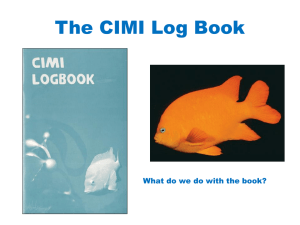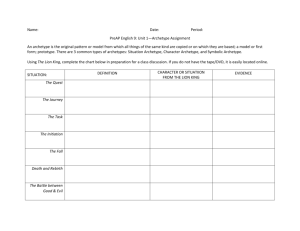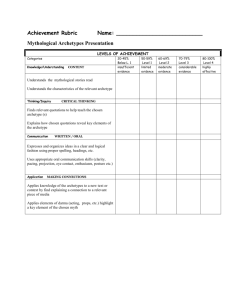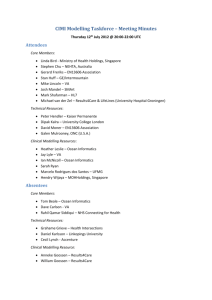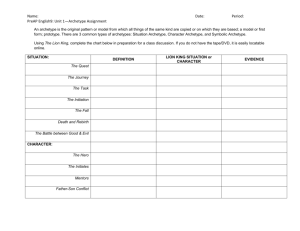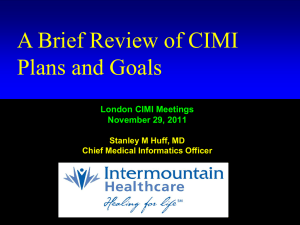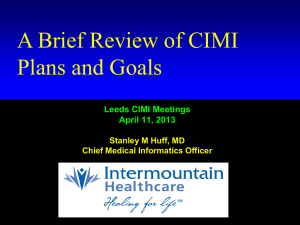CIMI Modelling Taskforce Report
advertisement
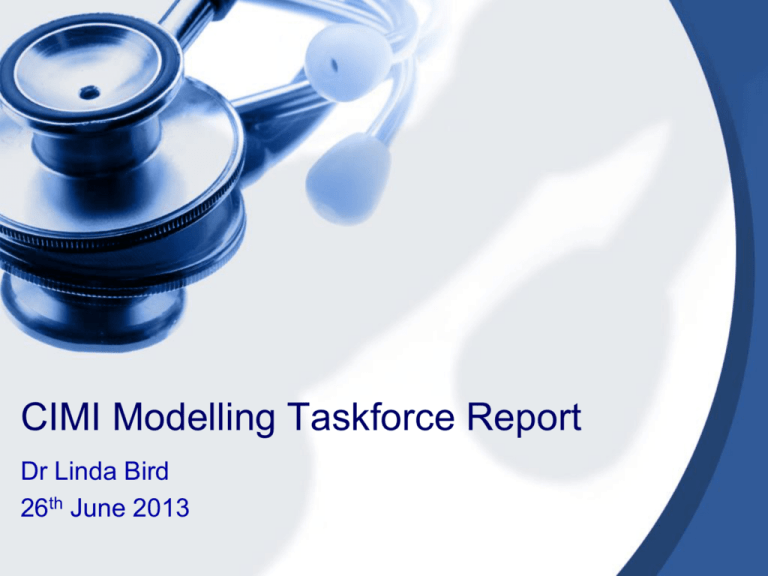
CIMI Modelling Taskforce Report
Dr Linda Bird
26th June 2013
Agenda
•
•
•
•
•
Background
CIMI Modelling Approach
CIMI Modelling Foundations
CIMI Modelling Methodology
Future Work
Tomorrow:
• Terminology Binding
BACKGROUND
Taskforce Members
Core Members:
• Linda Bird (co-chair)
• Harold Solbrig (co-chair)
• Tom Beale
• Dave Carlson
• Stephen Chu
• Stan Huff
• Mike Lincoln
• Rahil Qamar Siddiqui
• Gerard Freriks
• Josh Mandel
• Mark Shafarman
• Michael van der Zel
Secretary:
• Eithne Keelaghan
Technical Resources:
• Peter Hendler
• Galen Mulrooney
• Daniel Karlsson
• Cecil Lynch
• Joey Coyle
• Grahame Grieve
• Dipak Kalra
• David Moner
Clinical Modelling Resource:
• William Goossen
• Jay Lyle
• Ian McNicoll
• Anneke Goossen
• Heather Leslie
• Sarah Ryan
• Marcelo Rodrigues dos Santos
Terms of Reference
This taskforce has been established to:
• Develop CIMI's modelling methodology;
• Create an initial set of CIMI clinical models;
• Further test and develop CIMI technical models,
including:
– CIMI reference model
– Archetype Object Model 1.5, and
– CIMI terminology.
Modelling Taskforce History
May 10th-12th
May to Sep
Sept 14th-16th
Oct to Dec
Dec 2nd-4th
Jan 18th-20th
Feb – Mar
2012
Pleasanton meeting: Modelling Taskforce established
Taskforce infrastructure and planning
Modelling methodology
Observation modelling pattern
Heart rate model
Rockville meeting
Laboratory Results models and patterns
Terminology binding methodology & reference sets
Groningen: Taskforce meeting
2013
Scottsdale meeting
Terminology and Modelling Tooling
CIMI Modelling Style Guides (TOC)
Comparative Analysis Spreadsheet template
Laboratory Results Models
Example Terminology bindings
Lab Specialisation Models – CBC; Gas & CM Panels
Demographics models
CIMI Reference Model Review
Modelling Taskforce: Post-Leeds
Apr 4-6
Apr to June
2013
Leeds meetings
Technical/Implementation
CIMI Reference Model DSTU (link associations, instance ids)
Implementation artefacts: EA, BMM, XMI, XML Schema, XML, RDF
opencimi Github repository
CIMI URIs
Semver.org versioning rules
Archetype identification rules (openEHR)
CIMI-Mindmap to ADL conversion
Archetype Definition Language (ADL) 1.5
Archetype Modelling Language (AML)
Modelling
Unit of Measure: modelling style and approach
CIMI Model Example Instance Formats
Semver.org Versioning Rules
• Major version – incremented for a breaking change
• Minor version – incremented for non-breaking change
• Patch version – incremented for change to the informal parts
• Version modifier – e.g. “-rc” (release candidate), “-dstu” (draft
standard for trial use), “+u”
• Commit number – incremented every time artefact is committed
• First version rule = 0.0.1
E.g. 1.0.0-dstu
Archetype Identification Rules
Knowledge Artefact Identification (openEHR Foundation)
• rm_publisher = “CIMI”
• rm_closure in {“CORE”, “PARTY”, “DATA_VALUE”}
• rm_class_name: name of reference model class e.g. ENTRY
• concept_id: human-readable id of concept e.g. heart_rate
• version: as per semver.org rules
• Examples:
E.g. CIMI-CORE-ENTRY.observation.v.0.0.4
E.g. CIMI-CORE-CLUSTER.reference_range.v.0.0.1
E.g. CIMI-PARTY-ACTOR.person.v.0.0.2
Unit of Measure: Modelling Style
• Where global standard exists (e.g. Systolic BP in “mmHg”)
– CIMI Models will define specific Unit of Measure
• Where no global standard exists (e.g. Body temperature)
– CIMI General Model will restrict the property (e.g. mass
concentration, time, volume, pressure) of each quantity units by
binding to a reference set of valid alternative units for that property
– Jurisdictional specialisations can specialise the CIMI general models
to define the specific unit of measure used locally
– CIMI ‘Canonical/Preferred Model’ will be defined, which specialises
the CIMI General Model to the specific unit of measure to be used
when interoperability between jurisdictions is required
• CIMI Models will use SNOMED CT to define Units
• Jurisdictional implementations can choose to adopt other
code sets (e.g. UCUM), and map to SNOMED CT for crossjurisdictional interoperability
CIMI MODELLING APPROACH
CIMI’s Modeling Approach
•
•
•
•
•
•
•
•
Modular for reusability
Composable to meet use-cases
Pattern-based for consistency
Constraint-based to allow specialisation
Logical for implementation in multiple formats
Maximal for completeness
Extensible for local requirements
Bound to terminology for isosemanticity
& interoperability
CIMI Architectural Overview
Existing Clinical Models
Require
ments
DCM CEM CDA
openEHR ISO / CEN
LRA CMET RMIM
Clinical
Verification
Transform
Clinical Model
Editor
(AOM/AML)
CIMI
Reference
Model
Constrains
Instance of
M
0
M Clinical
2
Visualisation
Generate
Generate
Implementation Models
CIMI Model
Examples
Conforms to
International
Clinical Model
(AOM/AML)
Specialise
& Extend
Realm-Specific
Clinical Model
(AOM / AML)
Generate
CIMI Repository
Value
Value set
CIMI Terminology Server
Meaning
International
Reference
Terminology
Terminology
Workbench
Value set
Map
Value set
Meaning
National
Reference
Terminology
HL7 v2 HL7 v3 HL7 CDA
HL7 FHIR SOA OWL
openEHR ISO/CEN
XML Schema
Map
ImplementationSpecific
Terminology
Modelling Methodology
• Foundations
1.
2.
3.
4.
CIMI Reference Model
Archetype Object Model / Archetype Modelling Language
CIMI Modelling Patterns
CIMI Style Guide
• Modelling Approach
1.
2.
3.
4.
5.
6.
Analyse clinical models submitted (with value sets)
Identify maximal set of data elements
Remove ‘out of scope’ data elements (Style Guide)
Select appropriate CIMI Modelling Patterns(Style Guide)
Define CIMI model (Mindmap, ADL, UML)
Add Terminology bindings
o
o
7.
8.
Meaning (relationship, object, modifier)
Value sets (maximal set from submitted models)
Add Example Model Data Instances
Technical Validation
o
ADL, AML
9. Clinical Validation / Review
10. Confirm mappings from submitted models
FOUNDATION 1:
CIMI REFERENCE MODEL
CIMI Reference Model - Core
CIMI Reference Model – Data Values
class CIMI Data Value Types
IDENTIFIER
URI
EHR_URI
id :String
type :CODED_TEXT
issuer :String
YESNO
value :Boolean
CODED_TEXT
code :String
terminology_id :String
terminology_version :String [0..1]
term :String [0..1]
term_id :String [0..1]
TEXT
STRING_VALUE
language :CODED_TEXT [0..1]
PARSABLE
value :String
formalism :CODED_TEXT
value :String
target
DATA_VALUE
1..1
mapping
0..*
PLAIN_TEXT
ENCAPSULATED
TERM_MAPPING
MULTIMEDIA
match :Character
purpose :CODED_TEXT [0..1]
T : ORDERED_VALUE
alternate_text :String [0..1]
data :Byte [0..*] (Array)
media_type :CODED_TEXT
uri :URI [0..1]
0..1 upper<T>
ORDERED_VALUE
INTERVAL_VALUE
lower<T>
Character
upper_unbounded :Boolean
lower_unbounded :Boolean
upper_included :Boolean
lower_included :Boolean
0..1
TermMappingMatchEnum
>
=
<
?
QUANTIFIED
ORDINAL
symbol :CODED_TEXT
value :Real
value_status :String [0..1]
String
AMOUNT
DATE_TIME
QuantifiedValueStatusEnum
accuracy :Real [0..1]
accuracy_is_percent :Boolean [0..1]
COUNT
value :Integer
Name:
Author:
Version:
Created:
Updated:
CIMI Data Value Types
CIMI MTF
1.0.0-dstu.5
22/03/2013 9:00:10 AM
6/06/2013 11:31:22 PM
PROPORTION
numerator :Real
denominator :Real
precision :Integer [0..1]
type :CODED_TEXT
value :String
=
<
>
<=
>=
~
QUANTITY
DATE
value :Real
units :CODED_TEXT
precision :Integer [0..1]
DURATION
duration_text :String [0..1]
{units constrained to
units of time}
TIME
CIMI Reference Model – Party Model
class CIMI Party Model
LOCATABLE
archetype_node_id :String
name :String
uid :String [0..1]
PARTY_RELATIONSHIP
type :CODED_TEXT
details :ITEM [0..*]
relationship
0..*
source
PARTY
target details :ITEM [0..*]
1..1
Name:
Author:
Version:
Created:
Updated:
CIMI Party Model
CIMI MTF
1.0.0-dstu.5
25/04/2012 7:04:30 AM
6/06/2013 11:31:29 PM
ROLE
type :CODED_TEXT
role
0..*
ACTOR
type :CODED_TEXT
FOUNDATION 2:
ARCHETYPE OBJECT MODEL /
ARCHETYPE MODELLING
LANGUAGE
Archetype Object Model (AOM) 1.5
AOM 1.5 Archetype
AOM 1.5 Constraint Model
AOM 1.5 Primitive
AOM 1.5 Assertion
AOM 1.5 Ontology
Archetype Definition Language 1.5
archetype (adl_version=1.5) CIMI-RM-CLUSTER.anatomical_location.v1
concept
[at0000]
-- Anatomical location
language
original_language = <[ISO_639-1::en]>
description
original_author = <
["name"] = <"Ian McNicoll">
["date"] = <"29/11/2012“>
>
details = < ["en"] = < language = <[ISO_639-1::en]>
purpose = <" Identification of a single anatomical structure, or area, of the human body">
use = <"">
misuse = <"">
copyright = <"“>
>
>
lifecycle_state = <"AuthorDraft">
other_contributors = <>
other_details = <>
definition
CLUSTER[at0000] matches {
-- Anatomical location
items matches { ELEMENT[at0001] occurrences matches {0..1} matches {
-- Body site name
value matches { TEXT matches {*}
}
}
ELEMENT[at0002] occurrences matches {0..1} matches { -- Body site description
value matches { TEXT matches {*}
}
}
ELEMENT[at0003] occurrences matches {0..1} matches { -- Body side
value matches { TEXT matches {*}
}
}}}}
ontology
term_definitions = <
["en"] = <
items = < ["at0000"] = < text = <"Anatomical location">
description = <" Identification of a single anatomical structure, or area, of the human
body“>>
["at0001"] = < text = <"Body site name">
description = <"Name of anatomical location, as specific as is possible.“> >
["at0002"] = < text = <"Body site description">
description = <"Description of anatomical location.“> >
["at0003"] = < text = <"Body side">
FOUNDATION 3: CIMI
MODELLING PATTERNS
CIMI Modelling Layers
CLUSTER
ENTRY
SECTION
COMPOSITION
Implementation
Purpose Context
Laboratory Test
Result Item API
Laboratory Test
Observation GUI
Current
Medication List in
EHR
Laboratory Report
Message
Care Setting
Context
Inpatient
Laboratory Test
Result Item
Outpatient
Laboratory Test
Observation
Outpatient Clinic
Current
Medication List
Inpatient
Laboratory
Results Report
Use Case
Context
Full Blood
Count Test
Result Item
Current
Medication List
Full Blood Count
Results Report
Specialty
Context
Biochemistry
Test Result Item
Gas and Carbon
Monoxide Panel
Observation
Microbiology
Test
Observation
Cardiology
Medication List
Biochemistry
Laboratory
Results Report
Clinical Models
Laboratory Test
Result Item,
Refernce Range
Laboratory Test
Observation
Medication List
Laboratory
Results Report
Patterns
Observable,
Finding, Action,
Material Entity
Observation,
Clinical Activity
Request
Clinical List
Clinical Report
Reference Model
ENTRY modelling patterns
ENTRY
constrains
Clinical Entry
constrains
constrains
constrains
Clinical Report
Header
Clinical Activity
constrains
Request
constrains
Observation
Request
Observation
CIMI-ENTRY.clinical_entry
class CIMI Core Model
LOCATABLE
LINK
meaning :TEXT
link
source
archetype_details
archetype_node_id :String
target name :String
0..*
0..1
ARCHETYPED
archetype_id :String
rm_version :String = 1.0.11 {readOnly}
1
PARTICIPATION
participation
function :CODED_TEXT
0..*
details :ITEM [0..*]
CONTENT_ITEM
ENTRY
PARTY
party
CORE_LOCATABLE
data
1..*
ITEM
language :CODED_TEXT
constrains
1..1
details :ITEM [0..*]
CIMI-ENTRY.observation
ENTRY
constrains
Clinical
Entry
constrains
CLUSTER modelling patterns
CLUSTER
constrains
constrains
constrains
Observable
Material Entity
Finding
Action
constrains
Finding Group
Finding Item
Request Action
FOUNDATION 4:
STYLE GUIDES
CIMI Modelling Guides
• User Guide
– Modelling Framework
– Modellng Methodology
– Modelling Examples and Use Cases
• Editorial Guide
– Modelling Principles
– Modelling Patterns
• Terminology Binding Guide
–
–
–
–
Types of Terminology Bindings
Terminology Binding Rules
Terminology Binding Patterns
Terminology Binding Examples and Use Cases
• Technical Guide
–
–
–
–
–
–
CIMI Reference Model
Archetype Object Model
Archetype Definition Language
Archetype Modelling Language
Model Instance Representation
Model Transformation and Implementation
MODELLING METHODOLOGY
Modelling Methodology
• Foundations
1.
2.
3.
4.
CIMI Reference Model
Archetype Object Model / Archetype Modelling Language
CIMI Modelling Patterns
CIMI Style Guide
• Modelling Approach
1.
2.
3.
4.
5.
6.
Analyse clinical models submitted (with value sets)
Identify maximal set of data elements
Remove ‘out of scope’ data elements (Style Guide)
Select appropriate CIMI Modelling Patterns(Style Guide)
Define CIMI model (Mindmap, ADL, AML)
Add Terminology bindings
o
o
7.
8.
Meaning (relationship, object, modifier)
Value sets (maximal set from submitted models)
Add Example Model Data Instances
Technical Validation
o
ADL, AML
9. Clinical Validation / Review
10. Confirm mappings from submitted models
Comparative Analysis Template
• Purpose: To compare a set of existing clinical models,
and identify the maximal set of data items to be
included in the international CIMI models.
In so doing, it also documents the high-level mapping
from the CIMI data items to the source data models.
Comparative Analysis Template
Modelling Methodology
• Foundations
1.
2.
3.
4.
CIMI Reference Model
Archetype Object Model / Archetype Modelling Language
CIMI Modelling Patterns
CIMI Style Guide
• Modelling Approach
1.
2.
3.
4.
5.
6.
Analyse clinical models submitted (with value sets)
Identify maximal set of data elements
Remove ‘out of scope’ data elements (Style Guide)
Select appropriate CIMI Modelling Patterns(Style Guide)
Define CIMI model (Mindmap, ADL, AML)
Add Terminology bindings
o
o
7.
8.
Meaning (relationship, object, modifier)
Value sets (maximal set from submitted models)
Add Example Model Data Instances
Technical Validation
o
ADL, AML
9. Clinical Validation / Review
10. Confirm mappings from submitted models
Modelling Methodology
• Foundations
1.
2.
3.
4.
CIMI Reference Model
Archetype Object Model / Archetype Modelling Language
CIMI Modelling Patterns
CIMI Style Guide
• Modelling Approach
1.
2.
3.
4.
5.
6.
Analyse clinical models submitted (with value sets)
Identify maximal set of data elements
Remove ‘out of scope’ data elements (Style Guide)
Select appropriate CIMI Modelling Patterns(Style Guide)
Define CIMI model (Mindmap, ADL, AML)
Add Terminology bindings
o
o
7.
8.
Meaning (relationship, object, modifier)
Value sets (maximal set from submitted models)
Add Example Model Data Instances
Technical Validation
o
ADL, AML
9. Clinical Validation / Review
10. Confirm mappings from submitted models
Archetype Map for
Laboratory Results Report
Laboratory
Results Report
Composition:
Laboratory
Report Header
Patient Encounter
Summary
Entry:
Laboratory Test
Request Summary
Cluster:
Action
Action
Laboratory Test
Request
Laboratory Test
Observable
Action
Laboratory Test
Observation
Laboratory Test
Observable
Laboratory Test
Result Group
Specimen
Reference Range
Action
Entry
Laboratory Test Observation
ENTRY
constrains
Clinical Entry
constrains
Observation
constrains
Laboratory Test
Observation
CIMI-ENTRY.laboratory_test_observation
ENTRY
constrains
Clinical Entry
constrains
Observation
constrains
Complete Blood Count
ENTRY
constrains
Clinical Entry
constrains
Observation
constrains
Laboratory Test
Observation
constrains
Modelling Methodology
• Foundations
1.
2.
3.
4.
CIMI Reference Model
Archetype Object Model / Archetype Modelling Language
CIMI Modelling Patterns
CIMI Style Guide
• Modelling Approach
1.
2.
3.
4.
5.
6.
Analyse clinical models submitted (with value sets)
Identify maximal set of data elements
Remove ‘out of scope’ data elements (Style Guide)
Select appropriate CIMI Modelling Patterns(Style Guide)
Define CIMI model (Mindmap, ADL, AML)
Add Terminology bindings
o
o
7.
8.
Meaning (relationship, object, modifier)
Value sets (maximal set from submitted models)
Add Example Model Data Instances
Technical Validation
o
ADL, AML
9. Clinical Validation / Review
10. Confirm mappings from submitted models
Modelling Methodology
• Foundations
1.
2.
3.
4.
CIMI Reference Model
Archetype Object Model / Archetype Modelling Language
CIMI Modelling Patterns
CIMI Style Guide
• Modelling Approach
1.
2.
3.
4.
5.
6.
Analyse clinical models submitted (with value sets)
Identify maximal set of data elements
Remove ‘out of scope’ data elements (Style Guide)
Select appropriate CIMI Modelling Patterns(Style Guide)
Define CIMI model (Mindmap, ADL, AML)
Add Terminology bindings
o
o
7.
8.
Meaning (relationship, object, modifier)
Value sets (maximal set from submitted models)
Add Example Model Data Instances
Technical Validation
o
ADL, AML
9. Clinical Validation / Review
10. Confirm mappings from submitted models
Types of Example Instances
• Different example representation formats, e.g.:
– Clinical user interface form
– Mindmap example instance
– XML instance
• Reference Model vs Model Specific Instances
• Full vs Lite/Green Instances
Goal: Automated bi-directional transforms
• XML Instance Mindmap instance Clinical form
• Reference Model Instance Model-Specific Instance
• Full instance Green instance + Archetype
Mindmap Example Instance 1
Mindmap Example Instance 2
Mindmap Example Instance 3
Reference Model Instance
ENTRY
constrains
Clinical
Entry
constrains
Observation
constrains
Blood
Pressure
CIMI-ENTRY
class CIMI Core Model
LOCATABLE
LINK
meaning :TEXT
details :ITEM [0..*]
link
source
0..*
ARCHETYPED
archetype_details
archetype_node_id :String
target name :String
uid :String [0..1]
0..1
archetype_id :String
rm_version :String = 1.0.12 {readOnly}
1
participation
CORE_LOCATABLE
PARTICIPATION
party
function :CODED_TEXT
0..*
details :ITEM [0..*]
1..1 details :ITEM [0..*]
CONTENT_ITEM
1..*
data
ENTRY
ITEM
language :CODED_TEXT
1..*
item
CLUSTER
structure_type :CODED_TEXT [0..1]
PARTY
ELEMENT
null_flavor :CODED_TEXT [0..1]
value :DATA_VALUE [0..1]
Reference-Model Instance (XML)
<Entry xmlns:xsi=http://www.w3.org/2001/XMLSchema-instance xmlns=http://opencimi.org
archetype_node_id = “at0000.1.1” name = “Blood_pressure_observation” uid = “123456”>
...
<Data xsi:type = “CLUSTER” archetype_node_id = “at0002.1.1” name = “Observable” >
<Item xsi:type = “ELEMENT” archetype_node_id = “at0003.1.1” name = “Name” >
<Value xsi:type = “CODED_TEXT” value = “Blood pressure ” code = “75367002” />
</Item>
</Data>
<Data xsi:type = “CLUSTER” archetype_node_id = “at0004.1.1” name = “Results” >
<Item xsi:type = “CLUSTER” archetype_node_id = “at0005.1.1” name =
“Systolic_blood_pressure” >
< Item xsi:type = “ELEMENT” archetype_node_id = “at0007.1.1” name
“Systolic_value”>
<Value xsi:type = “QUANTITY” value = “120” >
<Units xsi:type = “CODED_TEXT” value = “mmHg” code = “259018001” />
</Value> </Item> </Item>
<Item xsi:type = “CLUSTER” archetype_node_id = “at0008.1.1” name =
“Diastolic_blood_pressure” >
< Item xsi:type = “ELEMENT” archetype_node_id = “at00010.1.1” name
“Diastolic_value”>
<Value xsi:type = “QUANTITY” value = “80” >
<Units xsi:type = “CODED_TEXT” value = “mmHg” code = “259018001” />
</Value> </Item> </Item> </Data> </Entry>
=
=
Model Specific Instance
ENTRY
constrains
Clinical
Entry
constrains
Observation
constrains
Blood
Pressure
Full Model Specific Instance
<Blood_pressure_observation xmlns:xsi=http://www.w3.org/2001/XMLSchema-instance
xmlns=http://opencimi.org rm_type = “Entry” archetype_node_id = “at0000.1.1” uid = “123456”> . . . . . . . . . . .
<Observable rm_type = “CLUSTER” archetype_node_id = “at0002.1.1” >
<Name rm_type = “ELEMENT” archetype_node_id = “at0003.1.1” >
<Value xsi:type = “CODED_TEXT” value = “Blood pressure ” code = “75367002” />
</Name> </Observable>
<Results rm_type = “CLUSTER” archetype_node_id = “at0004.1.1” >
<Archetype_details archetype_id = “CIMI-ENTRY.finding_group.v1” />
<Systolic_blood_pressure rm_type = “CLUSTER” archetype_node_id = “at0005.1.1” >
<Name rm_type = “ELEMENT” archetype_node_id = “at0006.1.1” >
<Value xsi:type = “CODED_TEXT” value = “Systolic blood pressure” code = “271649006” />
</Name>
<Systolic_value rm_type = “ELEMENT” archetype_node_id = “at0007.1.1” >
<Value xsi:type = “QUANTITY” value = “120” >
<Units xsi:type = “CODED_TEXT” value = “mmHg” code = “259018001” />
</Value> </Systolic_value> </Systolic_blood_pressure>
<Diastolic_blood_pressure rm_type = “CLUSTER” archetype_node_id = “at0008.1.1” >
<Name rm_type = “ELEMENT” archetype_node_id = “at0009.1.1” >
<Value xsi:type = “CODED_TEXT” value = “Diastolic blood pressure” code = “271650006”/>
</Name>
<Diastolic_value rm_type = “ELEMENT” archetype_node_id = “at00010.1.1” >
<Value xsi:type = “QUANTITY” value = “80” >
<Units xsi:type = “CODED_TEXT” value = “mmHg” code = “259018001”/>
</Value> </Diastolic_value> </Diastolic_blood_pressure> </Results>
Green Model Specific Instance
<Blood_pressure_observation>
<Subject_of_care> <Party> 456789 </Party> </Subject_of_care>
<Results >
<Systolic_blood_pressure>
<Value value = “120”> <Units value = “mmHg” code = “259018001”/
</Value>
</Systolic_blood_pressure>
<Diastolic_blood_pressure>
<Value value = “80”> <Units value = “mmHg” code = “259018001”/>
</Value>
</Diastolic_blood_pressure>
</Results>
</Blood_pressure_observation>
Full instance Green instance + Archetype
Modelling Methodology
• Foundations
1.
2.
3.
4.
CIMI Reference Model
Archetype Object Model / Archetype Modelling Language
CIMI Modelling Patterns
CIMI Style Guide
• Modelling Approach
1.
2.
3.
4.
5.
6.
Analyse clinical models submitted (with value sets)
Identify maximal set of data elements
Remove ‘out of scope’ data elements (Style Guide)
Select appropriate CIMI Modelling Patterns(Style Guide)
Define CIMI model (Mindmap, ADL, UML)
Add Terminology bindings
o
o
7.
8.
Meaning (relationship, object, modifier)
Value sets (maximal set from submitted models)
Add Example Model Data Instances
Technical Validation
o
ADL, AML
9. Clinical Validation / Review
10. Confirm mappings from submitted models
FUTURE WORK
Future Work
•
Foundations
–
–
Reference model: Documentation and testing
Archetype object model: Finalise support for terminology binding
Archetype modelling language: Finalise UML profile
– Modelling patterns: Documentation, Terminology bindings and Review
– Style guides: Complete content
•
Modelling
–
–
–
•
Implementation
–
–
–
–
–
–
–
•
Laboratory Results models: Example instances, specialisations, terminology bindings
Immunization models: Gather requirements, and define models
Temperature and other priorities: As above
Complete Mindmap-to-ADL generation for modelling patterns
CIMI Model Validators (Mindmaps, ADL, AML)
AML editor
ADL-to-instance generation
Model repository and visualisations
Model instance visualisations
Transformations to implementation formats
Governance
–
Establish modelling development, review and publication processes and procedures
Online References
• Taskforce Minutes
– http://informatics.mayo.edu/CIMI/index.php/Main_Page
• openCIMI Github repository
– https://github.com/opencimi
• Google groups email list (cimi-modelling-taskforce)
– http://groups.google.com/group/cimi-modellingtaskforce?hl=en-GB
QUESTIONS
TERMINOLOGY BINDING
Modelling Methodology
• Foundations
1.
2.
3.
4.
CIMI Reference Model
Archetype Object Model / Archetype Modelling Language
CIMI Modelling Patterns
CIMI Style Guide
• Modelling Approach
1.
2.
3.
4.
5.
6.
Analyse clinical models submitted (with value sets)
Identify maximal set of data elements
Remove ‘out of scope’ data elements (Style Guide)
Select appropriate CIMI Modelling Patterns(Style Guide)
Define CIMI model (Mindmap, ADL, UML)
Add Terminology bindings
o
o
7.
8.
Meaning (relationship, object, modifier)
Value sets (maximal set from submitted models)
Add Example Model Data Instances
Technical Validation
o
ADL, UML
9. Clinical Validation / Review
10. Confirm mappings from submitted models
Use Cases for Terminology in Models
1. Management and quality control of model libraries
a)
b)
c)
Searching model libraries
Identifying semantic overlap between models
Inconsistency of model interdependencies
2. Transforming between isosemantic representations of the model: both
a)
b)
Different levels of precoordination
Different model formalisms
3. Querying data instances of models (including clinical decision support)
which use different representations – for example:
a)
b)
c)
Different level of precoordiation versus structure
Different modeling design choices
Subsumption testing of values
4. Supporting data validation and semantic interoperability
Requirements for using Terminology in Models
1. Standard (reproducible) way of doing terminology bindings
2. The ability to represent the valid set of values for a given coded
element.
3. The ability to state the association between the intended
interpretation of nodes in the model and concepts in the terminology
4. Terminology bindings that are agnostic as to whether nodes are
connected using a hierarchy or using links.
5. Terminology bindings that allow the values to be represented in a way
that is agnostic to the degree of precoordination versus structure.
6. Terminology bindings that enable the transformation between
isosemantic representations of the same model
7. Terminology bindings that allow consistency to be checked within
models, and between models related by specialisation or used to fill
slots (using an underlying ontology).
Terminology Binding Approach
The meaning of each node has 3 parts:
• Relationship: The relationship from the parent
node to this node
• Object: The ‘class’ of things defined by this node’s
values
• Modifier: The context of the node’s meaning –
including subject-relationship context, temporal
context, procedure/finding context, negation, state,
certainty
CIMI Terminology Binding Approach
STRUCTURE
BINDING
TERMINOLOGY
Meaning
Value Set
Relationship
Object
Modifier
(Linkage
concept)
Pharm/biol
product
(Context
values)
-
Medication
Name
(Linkage
concept)
Pharm/biol
product
(Context
values)
Medication
Ref_Set
Element:
Ingredient
Has
ingredient
Substance
(Context
values)
Substance
Ref_Set
Element:
Basis of
Strength
Has basis of
strength
substance
Substance
(Context
values)
Substance
Ref_Set
Element:
Strength
Has strength
Measurement
Finding
(Context
values)
-
Element:
Dose form
Has dose
form
Drug dose
form
(Context
values)
Dose_Form
Ref_Set
Cluster:
Element:
Medication
Specialising Object Meaning
STRUCTURE
BINDING
TERMINOLOGY
Meaning
Value Set
Relationship
Object
Modifier
(Linkage
concept)
Oral dosage
form product
(Context
values)
-
Medication
Name
(Linkage
concept)
Oral dosage
form product
(Context
values)
Oral Medict
Ref_Set
Element:
Ingredient
Has
ingredient
Substance
(Context
values)
Substance
Ref_Set
Element:
Basis of
Strength
Has basis of
strength
substance
Substance
(Context
values)
Substance
Ref_Set
Element:
Strength
Has strength
Measurement
Finding
(Context
values)
-
Dose form
Has dose
form
Oral dosage
form
(Context
values)
Oral
Dose_Form
Ref_Set
Cluster:
Element:
Element:
Oral
Medication
Specialising Relationship Meaning
STRUCTURE
BINDING
TERMINOLOGY
Meaning
Medication
with Active
Ingredients
Value Set
Relationship
Object
Modifier
(Linkage
concept)
Pharm/biol
product
(Context
values)
-
Medication
Name
(Linkage
concept)
Pharm/biol
product
(Context
values)
Medication
Ref_Set
Element:
Active
ingredient
Has active
ingredient
Substance
(Context
values)
Active
Substance
Ref_Set
Element:
Basis of
Strength
Has basis of
strength
substance
Substance
(Context
values)
Substance
Ref_Set
Element:
Strength
Has strength
Measurement
Finding
(Context
values)
-
Element:
Dose form
Has dose
form
Drug dose
form
(Context
values)
Dose_Form
Ref_Set
Cluster:
Element:
Specialising Modifier Meaning
STRUCTURE
BINDING
TERMINOLOGY
Meaning
Value Set
Relationship
Object
Modifier
(Linkage
concept)
Pharm/biol
product
Current
-
Medication
Name
(Linkage
concept)
Pharm/biol
product
(Context
values)
Medication
Ref_Set
Element:
Ingredient
Has
ingredient
Substance
(Context
values)
Substance
Ref_Set
Element:
Basis of
Strength
Has basis of
strength
substance
Substance
(Context
values)
Substance
Ref_Set
Element:
Strength
Has strength
Measuremen
t Finding
(Context
values)
-
Dose form
Has dose
form
Drug dose
form
(Context
values)
Dose_Form
Ref_Set
Cluster:
Element:
Element:
Current
Medication
Filling Archetype Slots
STRUCTURE
Composition
Element:
Cluster:
Cluster:
BINDING
TERMINOLOGY
Discharge
Summary
Medical record
number
Primary
diagnosis
Diagnosis
Element:
Diagnosis
name
Element:
Onset
datetime
Meaning
Relationship
Object
Modifier
Has primary
diagnosis
Clinical
Finding
(Context
values)
Meaning
Relationship
Object
Modifier
Has diagnosis
Clinical
Finding
(Context
values)
Value Set
-
Value Set
-
Filling Archetype Slots
STRUCTURE
Composition
Element:
Entry:
Entry:
BINDING
TERMINOLOGY
Discharge
Summary
Medical record
number
Family history
Meaning
Relationship
Object
Modifier
Has
diagnosis
Clinical
finding
Family
member
Meaning
Diagnosis
Element:
Diagnosis
name
Element:
Onset
datetime
Relationship
Object
Modifier
Has
diagnosis
Clinical
finding
(Context
values)
Value Set
-
Value Set
-
Clinical Entry
Clinical Entry & Clinical Activity
constrains
Clinical Activity & Request
constrains
Request & Observation Request
constrains
Observation Request & Laboratory
Test Request Summary
constrains
Proposed Observation Bindings
